Museo del Prado - Altarpieces
last update: 20 Nov. 2019
In our visits to Museo del Prado we were stuck by many different masterpieces, and this page is dedicated to one type - the altarpiece (el retablo).
Altarpieces appeared from about the year 1000 AD onwards, thus running through the Late Gothic, Italian Renaissance, Northern Renaissance, and Counter-Reformation periods. Most altarpieces feature Biblical stories, with Saints and members of the Biblical family. There are two fundamental types of altarpieces, the reredos and the retable. The reredos is a large and elaborate construction in stone or wood, rising from the floor behind the altar. The retable is a simpler structure usually with painted panels, placed at the back of the altar itself. I'm not sure but I think a retable originally referred to a table or shelf behind an altar on which images and holy objects were placed (including framed painted or decorated panels). Some definitions mention that the retable is attached to the altar, whereas a reredos is separate from the altar. There is a suggestion that it is associated with screening the back or behind of the altar, so it could consist of decorated niches, panels, and carved wood or stone covering a wall behind the altar. According to some experts the word reredos fell in to disuse after ca. 1550 before being resurrected in ca. 1848.
The diptych, or 2-panel variety of retable, was usually created for personal veneration. The triptych, or 3-panel variety, and the polyptych, multiple-panel, were retables used for public worship.
___________________
Virgen de Tobed
(Jaime Serra, 1375)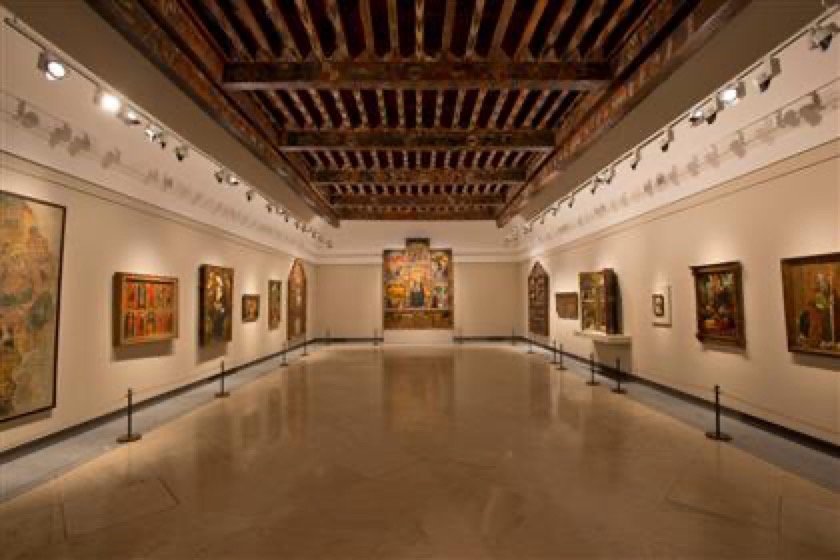
In 2013 a room (the Várez Fisa Room) was dedicated to 12 works from the period 1200 to 1500 donated by José Luis Várez Fisa (1928-2014). The total value of the 12 works was estimated at nearly €23 million. In fact he had been buying and donating early Spanish works from 1970, but now a room has been dedicated to those donations. He was an engineer and entrepreneur, originally in the field of steel derivatives. Later he founded a wealth and portfolio management company. One of the donated works was the Virgen de Tobad traditionally attributed to Jaime Serra. He died sometime after 1405, but was known to have been active in the period 1358-1390.
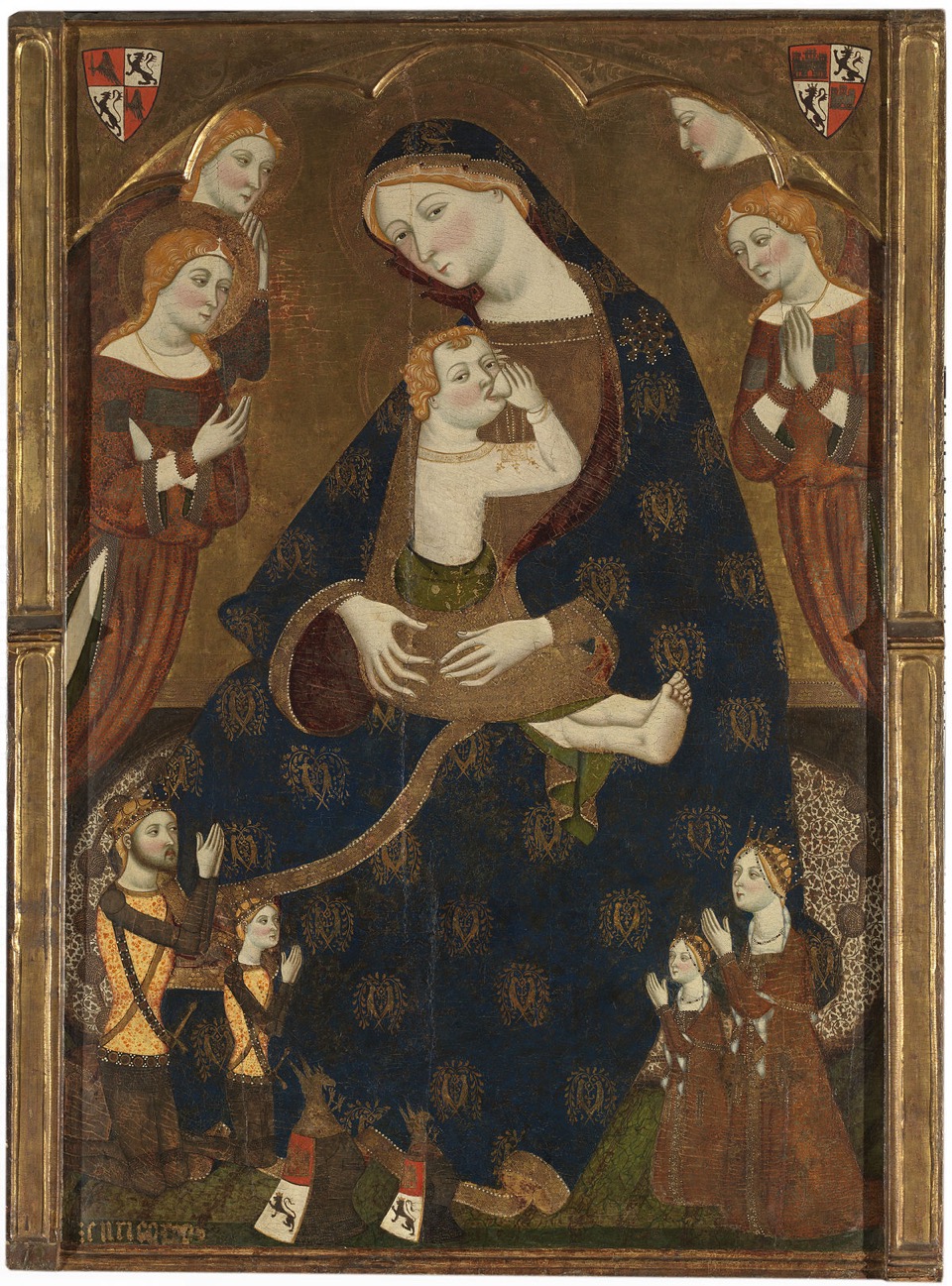
The full title is "La Virgen de Tobed con el future Enrique II de Castilla, su muter Juana Manuel y sus hijos" It was part of an altarpiece dedicated to the Virgin and found in the church in Tobed (Zaragoza). It is tempera painting on a wood panel, and has been dated to ca. 1375.

What we see is the Virgin in an arch with the coat of arms of Doña Juana Manuel and those of Castilla y León. She is stilling on the floor (Virgen de la Humildad) on a cushion. She hold in her lap El Niño, breast feeding (Virgen de la Leche). The upper part of the frame is celestial (in gold with angels and seraphs of Heaven), and the lower part, earthly, with rich fabrics. Praying at her feet are the Rey Enrique II de Castilla, his son the future Juan I, and the Reina Juana Manuel and her daughter Leonor. Some reports noted that the shields have no crown, but there is no doubting the link to the noble families. Don Juan Manuel (1282-1348) was one of the richest and most powerful men of his time, and he married three times, firstly to Isabel de Mallorca, then to Constanza daughter of Jaime II de Aragón (she was only 6 years old at the time), and finally Doña Blanca de la Cerda y Lara. Juana Manuel was the daughter of Doña Blanca, and the shields suggest that this altarpiece was dedicated to her. In addition there are references to Don Enrique II ordering the construction of three altarpieces making himself the principle character praying to the Blessed Virgin, and records show it being 'de Tobed'. And there are references to a painting of Jaime Serra given to the church in Tobed around 1373, so with the heraldic link everything points to this altarpiece as being the 'one' with its side panels.
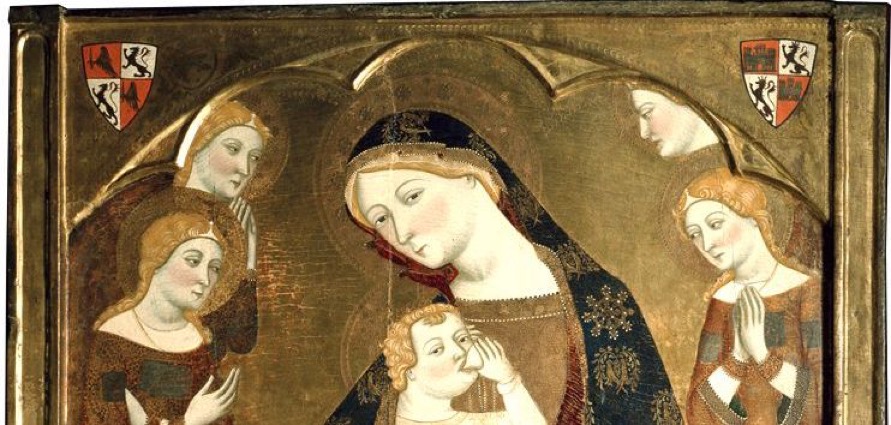
The Virgen de la Humildad (the Virgin sitting on the floor) appeared in France around 1340-1343, and spread rapidly into Italy, and then in to Spain and Germany. Humility was considered the root of all virtues, and during this period the trend was to humanise the Virgin, emphasising her tenderness and maternal instincts. The look of sadness is said to be related to the coming death of her son. The Virgen de la Leche, was a common theme in the Middle Ages, until it was banned by the Council of Trent (1545-1563).
The artistic language and the use of curved, compacted lines and soft blue and pink colours is typical of the Sienese school of Italian painting. However we cannot but note that the Child is too big, and those praying are too small. The Virgin’s breast is in an improbable place, and her neck is too wide. And the Child’s legs are unnaturally flexible. Of course we are not talking here of the later perfection of Flemish paintings. This was painted nearly 100 years earlier, and in the Gothic style.
The fact that we can see Enrique II and his wife Juana Manuel as queen, can help place the moment in history (we will not mention his mistress Leonor de Guzmán with whom he had 10 children). Enrique II was responsible for the Primera Guerra Civil Castellana (1351-1369). He used French mercenaries (the “White Companies”) lead by Beltran du Guesclin (ca. 1314-1380), and with the help of troops from the Crown of Aragon, they took Castile in March 1366. But Pedro I (1334-1369) fought back and obtained the support of the Principe Negro (Black Prince) and of Navarre and sent Enrique II running in 1367. When Pedro I did not pay the Black Prince, he left, and Enrique II could then re-built his army in Aragon, and take back Castile in 1369. Pedro I took refuge in a fortress. Du Duesclin offered to help him escape, but instead he actually helped Enrique II kill Pedro I.
Pedro I is often called “The Cruel”, but at the time the people called him “El Justiciero” because he enacted laws concerning trade and looked to the security of the State. The Castilian Civil War was not a dynastic conflict, but one between the bourgeoisie and the aristocracy. The power of land-owning wealth won over the development of industry and commerce, and it saw the abusive privileges of the Mesta reinforced (the Mesta were the nobility and religious orders who acquired ranches during the Reconquista and benefited from the export of merino wool).
It is wonderful to see how an in depth analysis of a simple altarpiece can provide an insight into great political movements. In fact, at the time the Castilian economy was reduced to a monoculture of wool, which was then exported to Flanders to make expensive fabrics. And here we see Spaniards buying works of art and importing the Flemish style back into Spain, creating the hispano-flamenco movement.
The (unpublished) story is that the altarpiece disappeared from Tobed sometime between 1898 and 1901, and reappeared in an exhibition in Zaragoza in 1908. There is talk of the improper use of parish funds, and possibly the sale of other objects in the church without informing either the bishopric or the local town council. The owner at that time, a certain Román Vicente, said that he had purchased it from an antiquarian. A letter sent to bishopric in 1909 asked for the authorisation to sell other items in the church, and noted at the same time that the altarpiece and some jewellery were missing. The altarpiece reappeared in 1962 in an exhibition on Catalan paintings in Madrid, on loan this time from a collector called Fernando Birk.
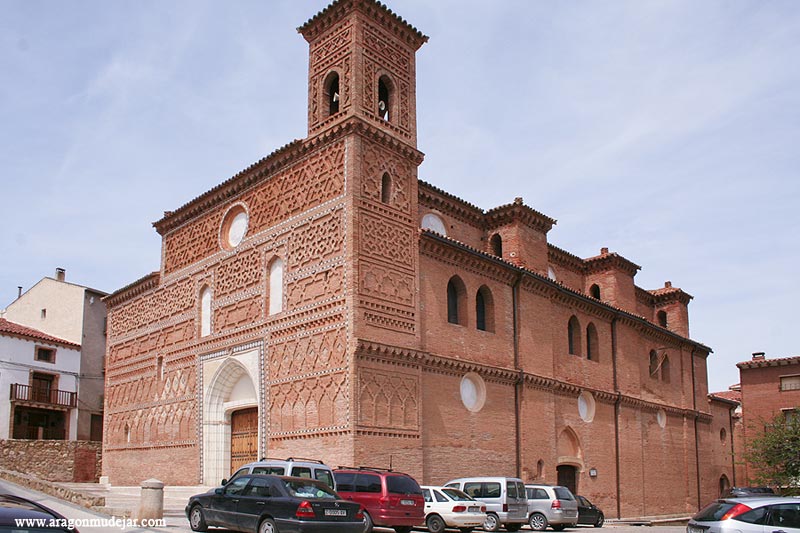
The Church of the Virgin of Tobed is church-fortress in the Aragonese Mudéjar style. Mention is made in 1359 of altars to the Holy Mother, Saint John the Baptist and Mary Magdalene, set in a triple chapel. A more detailed mention is made in 1375 concerning panels of the Nursing Virgin, Narratives of Saint John the Baptist, and Narratives of the Magdalene. However the church remained uncompleted until 1385, and payments for the building were registered through to 1410. It would appear that the three presbytery chapels were built by 1359, then bays of the nave were added afterwards. It is probable that Enrique of Trastámara, as Enrique II King of Castile in 1375, donated the three painted panels for the presbytery chapels.
There is a fantastically detailed set of webpages on this magnificent church, with more than 50 pages of detailed photographs and comments. The website is a testament to the authors interest in the Mudéjar style.
Jaume was one of four children of the Barcelona tailor Berenguer Serra, the three sons becoming painters. When his older brother Francesc died in 1362, Jaume took over the workshop in collaboration with his other brother Pere. There are only two fully documented works of Jaume Serra, one in the cathedral of Barcelona and the other in Zaragoza. This work was 'ascribed' to Jaume in 1986, and is considered an early work, when his brother Francesc was still alive (so sometime between 1356-1359). There is an earlier attribution of Jaume dating from 1955. There is an ongoing discussion about works coming from workshops such as that of the brothers Serra, since it is difficult to isolate 'the hand' of one artist from another. The 'simplicity' of the composition has been attributed to Jaume.


As a final word, the Prado also hold two of the side panels of the original altarpiece. The left panel is home to the story of Mary Magdalene (washing the feet of Christ, etc.). The right panel is home to the story of San Juan Bautista, with Salomé dancing for Herod and later asking for the head of John the Baptist.

I can't resist including another painting (above) by Jaume Serra, the Descenso de Jesús al Limbo. This is a relatively common topic, but I just think the treatment here is almost surrealistic.
___________________
El Retablo de San Cristóbal
(unknown, late 13th C)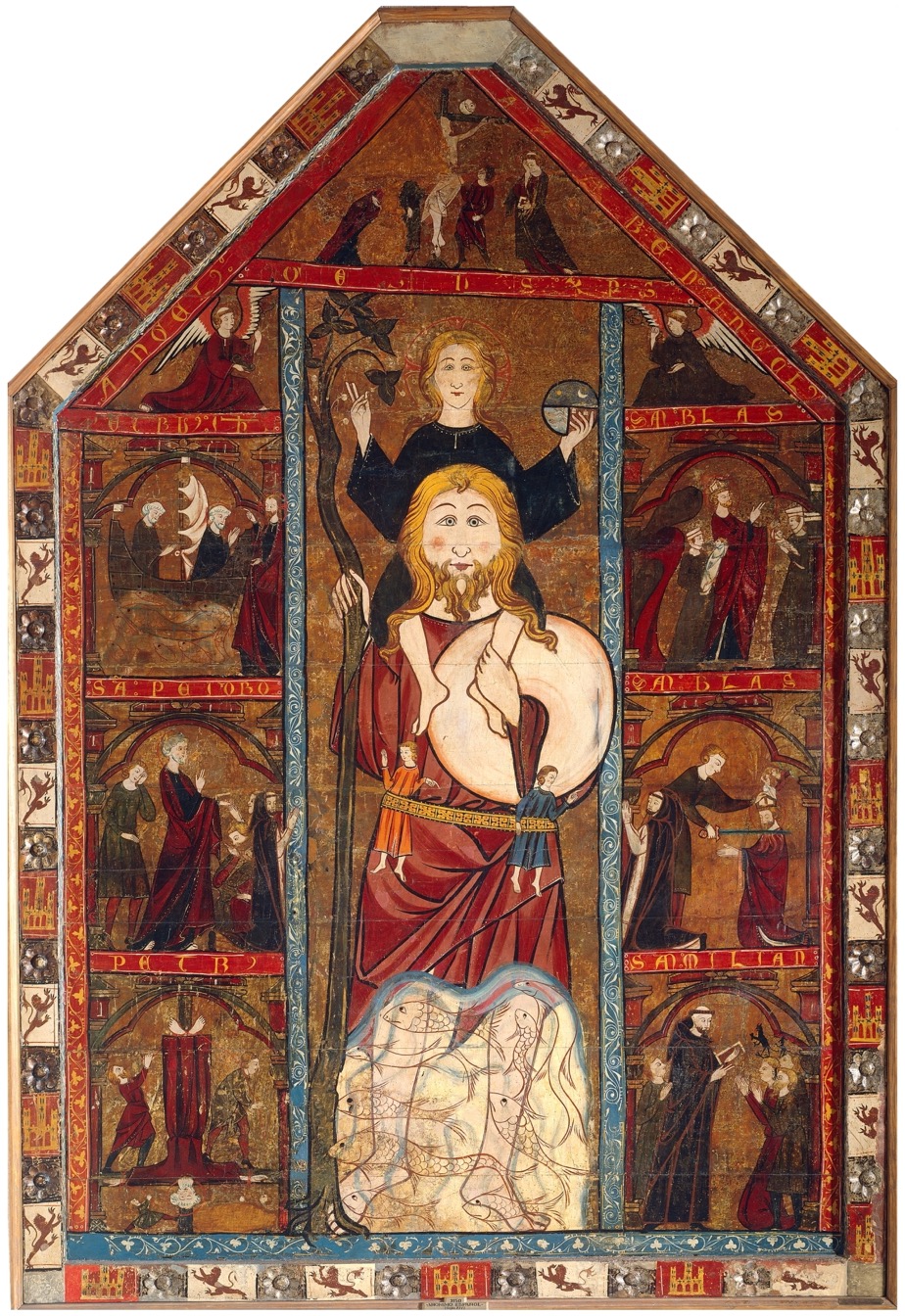
The history of El Retablo de San Cristóbal is patchy (to say the least), but to the experts it is a Castilian painting of an early Linear Gothic style (Castilian Franco-Gothic). Its very existence and integrity makes this altarpiece exceptional. It is a small altarpiece dedicated to San Cristóbal (Saint Christopher) who protects against sudden death (small, but it's still 2.75 meters high). The artist is unknown, but the period is late 13th C to 14th C.
Linear Gothic is a style that is defined by the predominance of the line, not only to delimit figures, but also to mark landscapes, and details such as hair and the folds of clothes. Figures are flat, with some volume being defined by complicated folds in dresses, etc. Colours are usually vivid, simple, without shades, or shadows. There is no perspective, and gold is ever present. Figures are stylised, with elongated hands, but painted with great care. Animals are abundant, but not particularly natural. However animals are detailed enough and often add considerable charm to a work. Landscapes are just frames for the scenes, e.g. trees are just lines topped with blobs. Altarpieces display great symmetry, and can be framed with architectural features. The use of colour was more subtle in northern Spain, and backgrounds can occasionally include furniture and even utensils. Figures have more expression. The Linear style could be quite striking, and endured throughout the 14th C.
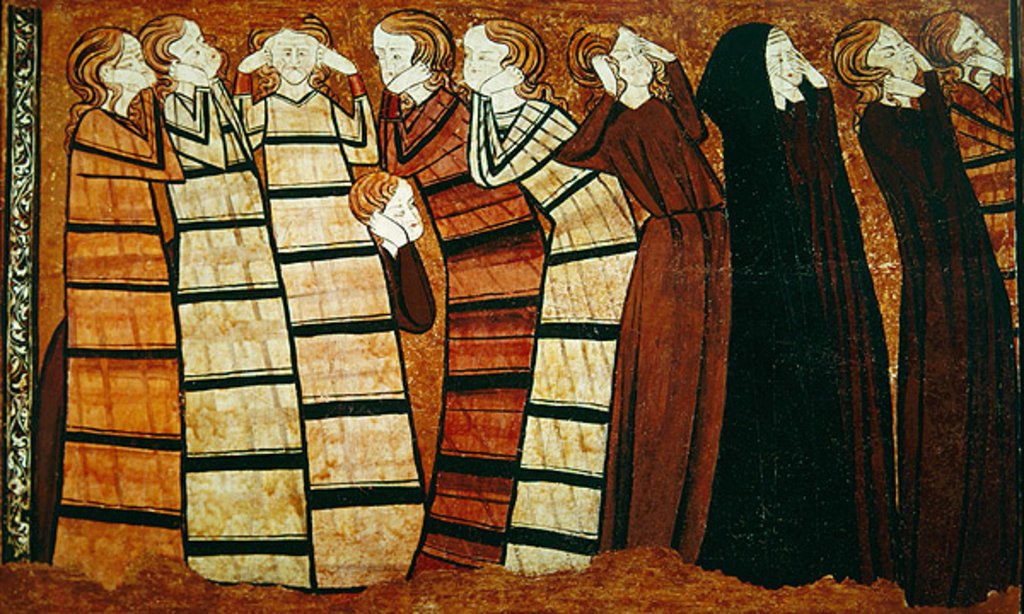
Above we can see a detail of the tomb of Don Sancho Saiz de Carillo (ca. 1300) created by an unknown artist and presently in the Museu Nacional d'Art de Catalunya. This work is often used to highlight the Linear Gothic in both ideology and aesthetics. The individual started to become more important and in particular when expressing emotions. It was a time when this world started to gain importance as compared to the afterlife, as an example, funeral monuments started to become important. The very concept of death was changing. Death was no longer a liberation from this terrible world. Death started to become a tragedy, a moment for pain and tears. The aesthetic canon changed towards a new form of beauty. The tradition of hieraticism were questioned. People no longer needed to be presented with a strict frontally, with a pure symmetry, and with the heads of the figures all brought to the same level (isocephalic). People became slimmer, bodies became more sinuous, and they acquired individual features and expressions, e.g. showing pain. Public weeping was traditional as was the hiring of professional plañideras (mourners). At one time the tears would be collected and incinerated along with the deceased. Some experts have even suggested that professional Egyptian mourners were the worlds first actresses.

My understanding is that what we see in this altarpiece is San Cristóbal (the bearer of Christ) taking a boy (the young Jesus as identified in an inscription on the frame) on his shoulders and crossing a dangerous ford (see the fish and eels in the water). In this sense San Cristóbal was also the protector of pilgrims.
It is composed of 10 planks of wood arranged horizontally, held within a frame. The surface is smooth, and there are no articulated sections. This arrangement in itself marks a shift in the design of liturgical furniture. We have the Saint, surrounded by episodes of his life.
This style (Saint surrounded by episodes of his life) is typical for 12th C Byzantine 'vita' icons, and emerged from the eastern Mediterranean region. The style is similar to Italian altarpieces of the 12th C and 13th C, particularly 13th C Tuscan altarpieces. However, Italian altarpieces of the period were usually more monumental in size, with larger panels. Whilst we do not know for sure the original use of the early Byzantine 'vita' icons, the Italian panels were clearly designed as altarpieces. Equally the San Cristóbal altarpiece was also clearly intended as an altarpiece.
In fact the living icon ('vita' icon) emerged in the late 12th C and early 13th C, and was quickly adopted by the Franciscans in north-central Italy. Without going "over-the-top” these icons displayed the Saint, and what he was like in real life. Some authors see this type of icon as a tool to get people to think about the actual life of the Saint, what he did that defined him as a Saint. It was also a style that replaced the earlier 11th C manuscript style icons. Franciscan 'vita' icons differed in that they included posthumous miracles. We must not forget that the icons were seen as relics, and not just material representations.
Just as the Italian adapted the Byzantine icon model, so did the Castilian artist adopt the Italian altarpiece model. The size was different, and the frames were generally less architectural, and usually not carved. The painted frame on this altarpiece could have been added later. Also, unlike the Italian style, the main figure does not occupy the entire height of the altarpiece. On the other hand the placing of small angels is typical of the Italian style, and confirms that Castilian style altarpieces were very much inspired by the original Italian style. Experts have suggested that the context for this altarpiece might have been a parish church or priory. There is even a suggestion that the artist might be the anonymous “master of Añastro”, who is documented to have worked in Burgos and in Medrano (La Rioja).
The “maestro de Añastro” was identified by comparison with other Linear Gothic altarpieces in the region between Bilbao and Burgos (Basque region) and west of the La Rioja region (Medrano). The conclusion was that there was a well organised and capable workshop in the region during the late 13th C and early 14th C (possible home to two different artists). This is all about identifying technical and style differences within a more or less well-defined artistic period. One technique identified as being characteristic of the “maestro de Añastro” is the treatment of clothing, and in particular the way folds are shown by simple, long and straight black brushstrokes, set against angular brushstrokes to create the idea of folding with a “v” (angels appear to float and have more complex folds in their garments). The artist often concealed the feet under the clothing. Another characteristic technique mentioned is the way hair was worked as strands of shaded yellows with light and dark tones trying to create a rudimentary sense of volume. The painting of stones as round with vertical lines is said to be one of the artists most characteristic features (including the insertion of almost invisible clover leafs). The faces are characteristic, with three lines defining eyes, and the lines are not quite joined together. Faces are quite round, lips closed, eyes round, and with stylised noses. It is in the treatment of faces that the hands of two artists have been suggested. At that time the backgrounds were not that elaborate, but the use of losanges are also suggestive. As far as I know there are three altarpieces that have firmly been attributed to the “maestro de Añastro” (but there are numerous altarpieces from that period and region that have, as yet, no attribution). Experts would put the “maestro de Añastro” as “marginal” in terms of art history, but the techniques used and the style adopted surpass local skills and suggest a broader understanding of the stylistic trends for the period. Dating the works to the late 13th C suggests that there was a significant stylistic delay before Linear Gothic 'arrived' at this workshop, but we should not forget the high technical skill displayed.
This particular altarpiece includes scenes from the lives of Saint Peter, Saint Blaise and Saint Millán (this Saint might suggest a link with the La Rioja region). In this sense the altarpiece is not designed to inspire through the story of San Cristóbal’s life, but to suggest the benefits that the faithful have when following the examples given by the Saints.
Behind such icon-altars there is often a well established story-history. The name Cristóbal means Christ-bearer. It refers to a legendary saint who originally was a soldier in search of the world's most powerful master. He entered the service of a King, but when the King showed fear of the devil, he pledged himself to Satan. But he also left his service after he had a vision of the cross. A hermit told the soldier of Christ as the powerful master that he was looking for. But in order to find him the soldier was told that he must place himself as the service of travellers and pilgrims that had to cross a river without a bridge. One day, when he was transporting a child, Cristóbal felt a progressive weight that sank him in the water. He was required to support himself and the child on a dry trunk in order to get to the other side. When he reached the other side, a hermit guided him in the night. The child was revealed as the King of Heaven and Earth by making Cristóbal drive his wooden staff in the ground, which soon became a palm full of dates.
Cristóbal is a well known theme, and was usually presented as a giant bearded pilgrim and traveller. He has his skirt rolled up to his knees and fastened by a belt. He will often carry his passengers on his shoulders. Often fish are presented swimming between his submerged legs, and there is often a hermit with a lantern sitting on the other shore.
An important tradition was that it was sufficient to look at the image of San Cristóbal to be safe all day long. Later the idea was that those who contemplated his face would not perish from a bad death. It would appear that the tradition and iconography of San Cristóbal came from the Coptic world and gradually became more and more popular in Europe. There have been at least two attempts to eliminate the cult of San Cristóbal, one in the 16th C and the second more recently in the 20th C. But it persevered in the Renaissance and Baroque countries, such as Italy, France, Germany and especially in Spain.
We can see in this example that the Child is holding an orb, which is often considered an echo of the pagan theme of Atlas holding the world. There are those who see in San Cristóbal a link with the mythology of Egypt (Anubis the God of the dead) and/or Greece (with Aeneas son of Aphrodite and Anchises). At times San Cristóbal was seen as the symbol of both physical and moral strength, and ultimately as the guardian god of the necropolis. San Cristóbal was invoked against the plague, against the 'evil eye', toothache, as well as protector of fruit trees, and helper in finding hidden treasures.
___________________
Retablo de la Virgen
(Maestro de Torralba, 1435-1440)
This altarpiece consists of three pieces sitting on a predella (6 of the 7 panels still exist). The central panel is dedicated to the Virgin and Child. Above that there is a Crucifixion in the style of Aragón. Tradition imposes that on the left there is the Annunciation and the Birth of Christ, and on the right, the Adoration of the Magi and the Presentation of Jesus at the Temple.

The way the buildings are presented is typical of the later part of the 14th C (frontal with little perspective). The way the people are drawn with long vertical lines, the use of bright colours such as blue and pink, and the sinuous curvilinear lines of the many fabrics, is typical of the International Gothic style.
It is thought that the work was painted for a church in Torralba de Riqueza (Zaragoza), and some experts have suggested that the artist was Juan Arnaldin (ca. 1415-1492). The attribution is made because of similarities in technique with two other altarpieces made for a church in Torralba de Ribota. Considerable attention has been paid to the figure of a woman with blond hair and a pink dress (she sits in the “frame” on the right, and we can almost not see her). This is Saint Lucia (de Siracusa), and from the 14th C she was presented with shining eyes (from the latin lux) and holding a kind of tray.
_________________
Tríptico del Zarzoso
(Maestro del Triptico del Zarzoso, 1450)
This is the Triptico del Zarzoso, otherwise known as the Triptico del Nacimiento de Jesús (Birth of Jesus). It dates from 1450 and the artist is unknown (so is now known as the Maestro del Triptico del Zarzoso).
We have already mentioned the Várez Fisa Room, and 12 works from the period 1200 to 1500 donated by José Luis Várez Fisa. This particular tríptico was purchased directly from Várez Fisa for €4 million, and is now one of the 18 works presented in the room.

The work is in three parts, the Birth of Jesus in the middle, on the left we have the Assumption of the Virgin, and on the right we have the Presentation of Jesus at the Temple and the Adoration of the Magi. One suggestion is that in 1444 this work was with the Franciscan nuns of the convent of El Zarzoso in the town of El Cabaco (Salamanca). However the back of the altar has the Zúñiga (Estúñiga) coat of arms (in Navarre), and the mark of the house of Osorio. This would suggests that the triptych was commissioned around 1450 by Doña Elvira du Zúñiga.
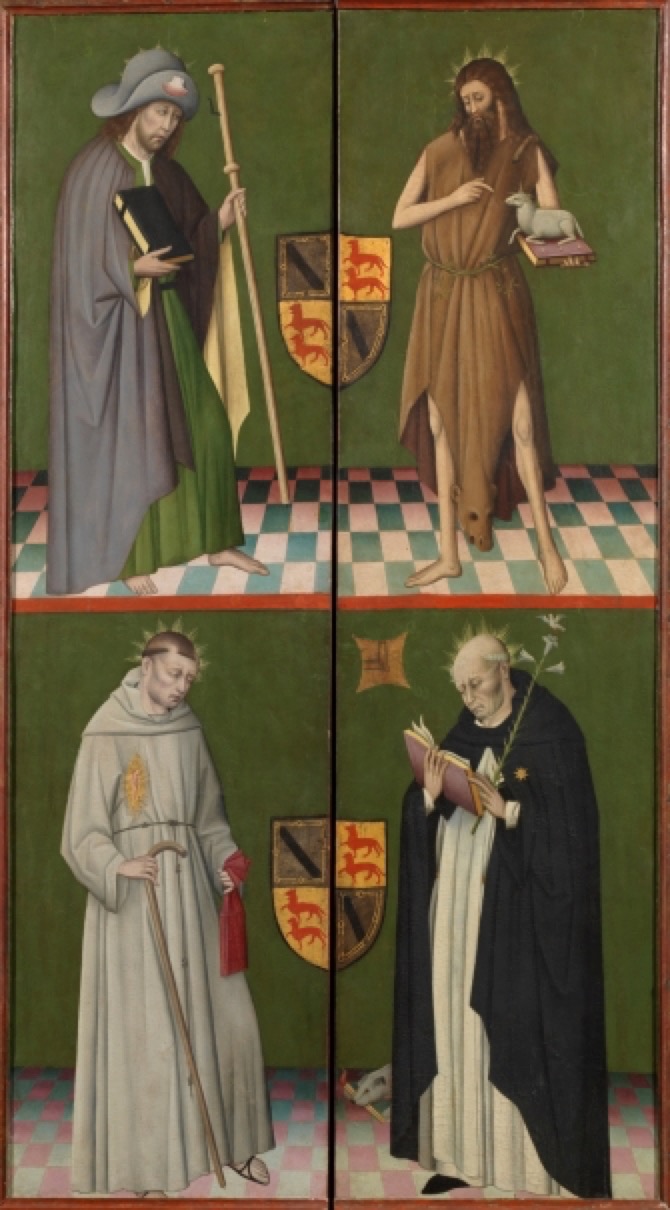
We can see on the back on the top left Santiago el Mayor next to San Juan Bautista on the right. And below left we have San Antonio de Padua (or depending upon the source San Francisco de Asís) and on the right Santo Domingo de Guzmán.
Some experts think that the artist was both a painter and mathematician, and was trained in the International Gothic style in France rather than in Flanders. Other experts see the style as being closer to the Flemish school, or possible even some German painters. The artist has a very unique way of producing very marked shadows. Nothing is actually known about this artist, so his style is his only calling-card. Despite the fact that the style is so unique, and other examples of this artist would be easily recognisable, none have been found. Radiography of the wood confirmed that the painting was executed in Castile.
The elongated faces, the expressions and the shape of the mouths, suggest a painter originally from the northern Netherlands or Germany (some experts have even suggested that the artist was of Nordic origin). The artist clearly loved detail. The shoes of the Virgin are Castilian chapines with Islamic motifs. The garlic hanging on the wall, the cook working in the background, the plate with cherries, all shown a fanatical interest in detail. And detail totally unusual for the year 1450. The black king with his black page in the Adoration of the Magi, is very unusual, and will only become generalised many years later. The inclusion of two black angels in the Assumption is, if anything, even more unusual. However the style used to represent the Saints is not Flemish, and the landscapes appear to be set near Santiago. The rich gold-embroidered fabrics with different sized motifs are typical of the Burgos artist Juan Sánchez. The conclusion is that we see here the work of a transitional painter (late-13th C Romanesque to mid-15th C Early Renaissance, through late-14th C International Gothic). Possibly someone trained in the International Gothic, but receptive to the novelties of the Flemish school.
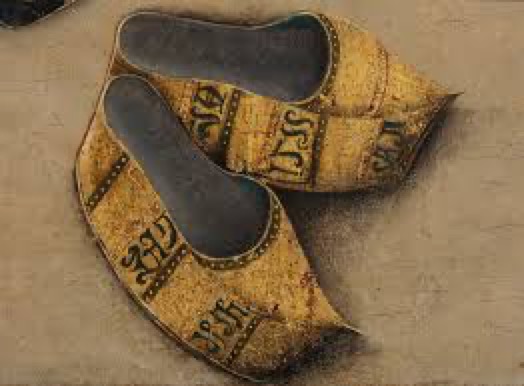
___________________
El Retablo de los Gozos de Santa Maria
(Jorge Ingés, ca. 1455)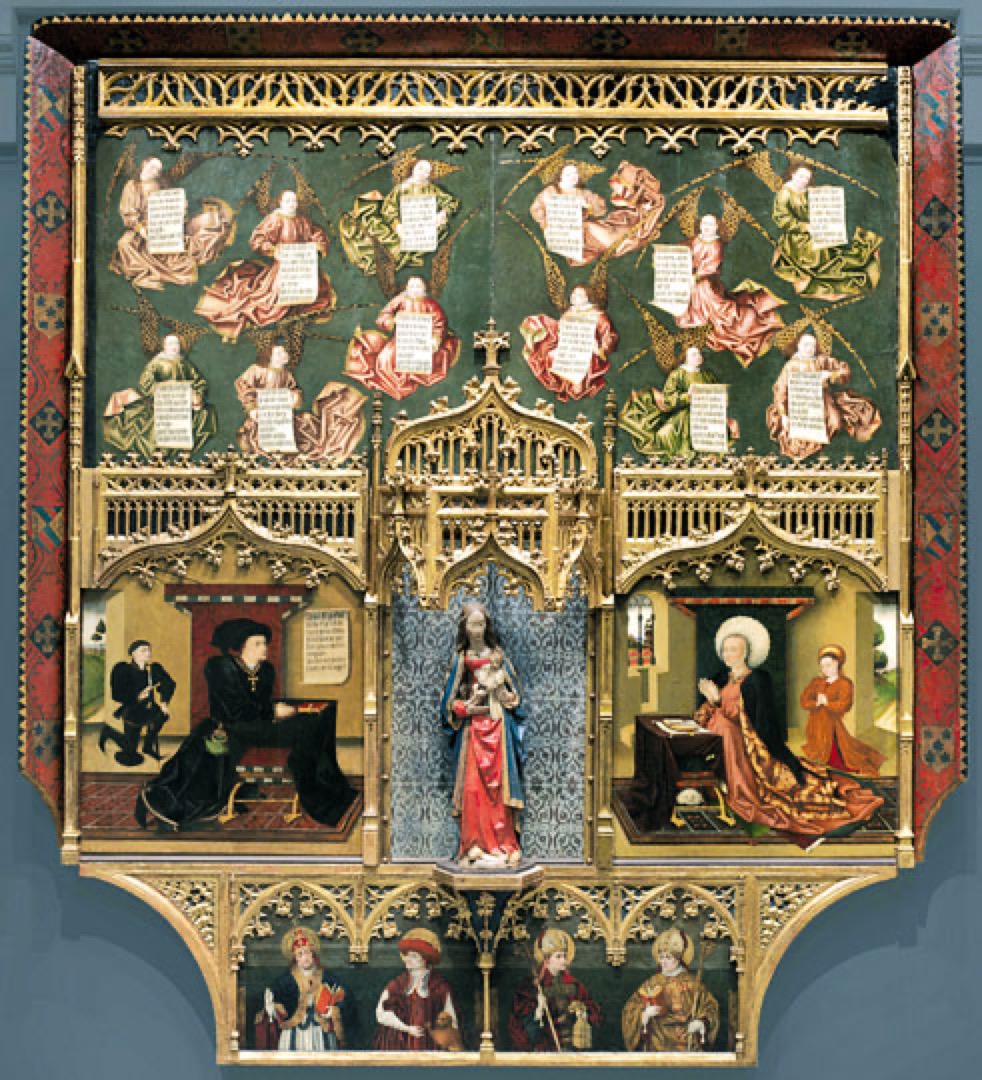
The Altarpiece of the Gozos de Santa María (Gozes is Joy) was commissioned in 1455 by Íñigo López de Mendoza (1398-1458), a Castilian politician and important poet (and an admirer of Dante Alighieri). It was intended for the Hospital de Buitrago in Madrid, which was also founded by López de Mendoza (the hospital was destroyed in the 20th C). López de Mendoza was particularly devoted to the Virgin, and he wrote some devotional verses known as the Gozos de Santa María, which inspired the altarpiece. Some of the verses are inscribed on the scrolls carried by the angels at the top of the composition. López de Mendoza is often known by the title Marques de Santillana, and the altarpiece is also known as the altar de los ángeles (altar of the angels) and has in the past been called the Rentable del Marqués de Santillana. One of the sons of López de Mendoza was granted the exceptional title of Duque del Infantado for his constant allegiance to Isabel I de Castilla. Another son became Cardinal Mendoza (and was Archbishop of both Toledo and Sevilla), which did not stop him become a military leader and farthering three children.
The altarpiece is on display in the Prado for a period of 10 years (2012-2022 after restoration), with the agreement of the present owner (XIX Duque del Infantado, Íñigo de Arteaga y Martín).
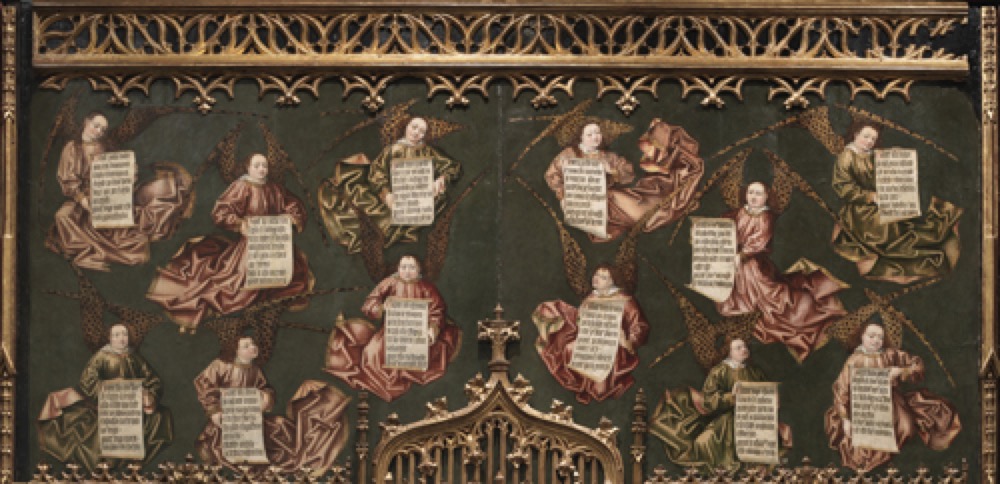
The altarpiece retains part of the original structure and traceries and all the paintings executed by Jorge Inglés, and is in fact the first fully documented work by him. Jorge Inglés is known as a painter of the Castellano hispano-flamenco school (Spanish-Flemish school). We have a pinewood base, as was usual with Spanish panels, and the underlying drawing was very elaborate and unevenly distributed, with abundant changes and lots of brushstrokes of differing lengths, thicknesses, and shapes (particularly intense where the rendering of volume was intended). There is evidence that the artist was drawing without having a very clear idea of the final composition. Oddly the face of Doña Catalina was drawn very precisely and without any alterations. This was unheard of until the 15th C with the drawings of Dürer.
We know little about Jorge Inglés, but given the name it is possible that the family was of English origin. He was known as a painter and miniaturist, but we do not know where he was born or trained. This altarpiece is in fact the starting point for isolating his technique and style. The attribution hispano-flamenco is used because his style suggests prolonged contact with Flemish painting (his name is suggestive of contact with the English style of painting). Experts agree that the painter displayed great “correctness and neatness” within the knowledge and technique of that time. The only documented evidence on this painter is a reference in the will of López de Mendoza. There is evidence concerning a debt of a Jorge Inglés, being from Bristol, but residing in Spain (but no profession is mentioned). Experts have seen in the hand of Jorge Inglés traces of the painter Robert Campin (1375-1444), an early Flemish master (in particular the way contours are highlighted). Others have seen some technical and stylistic links with Rogier van der Weyden (1399-1462), and in particular his polyptych of the Last Judgement commissioned for the l’Hotel-Dieu in Beaune. What is certain is that the style is Flemish, and whilst examples are frequently found in Flanders, they are exceptionally rare in Castile.

If we start with the predella, on which the main altar stands. We see the four fathers of the Western Church, St. Gregory Magno, St. Jerome, St. Augustine, and St. Ambrose. Above them we find a portrait of Íñigo López de Mendoza (detail above) and a portrait of his wife Catalina Suárez de Figueroa. Each is kneeling before the Virgin Mary (Virgen María).

The figure in the altarpiece is a replacement of the original Flemish 15th C figure, and is a recently renovated Romanesque figure (dated from about 1480-90). A larger, possible original, figure was present in photographs taken in 1907. In the upper part of the altarpiece there are 12 angels carrying scrolls with texts from the poem written by Don Íñigo (possible the so-called doce gozos or twelve joys). The portrait of López de Mendoza is important in Spanish iconography because it is the only painting known to exist of a noble of the court of Jean II de Castilla (1405-1454).
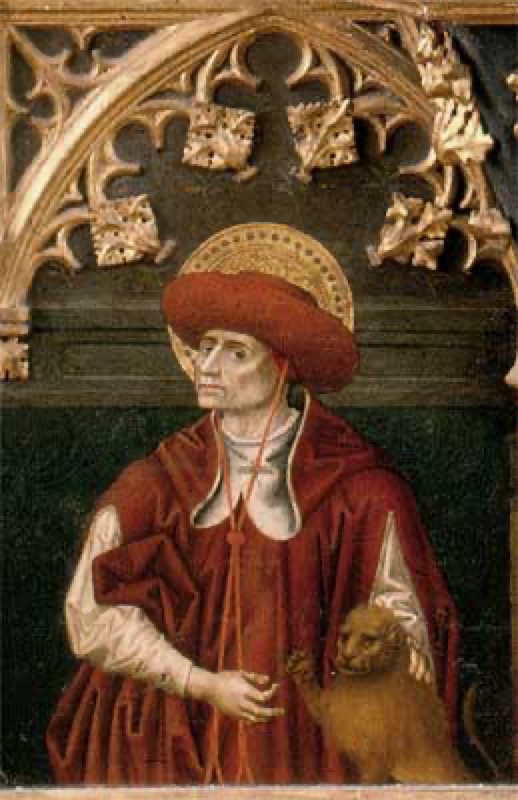
The above is (I think) St. Jerome but I am far from sure (he was often depicted as a Cardinal). I can find no reference to St. Jerome and monkeys (except the word primate of course). However monkeys were popular in Flemish paintings, and represented everything from entrapment by earthly desires through to expressing the wonders of the universe.
Photographs and earlier descriptions (going back to 1787) suggest that the predella was actually hidden behind the altar. Early photographs suggest that the altarpiece had been modified over time. The place of the Virgin Mary looked Baroque at that time, but clearly in a later restoration the original Gothic appearance had been recovered.
It is interesting that each of the angels has a specific role, and each holds a different joy written by López de Mendoza. They are Annunciation, Visitation, Birth of Christ, Adoration of the Kings, Presentation at the Temple, Annunciation in Egypt, Christ among the Doctors, Marriage of Cana, Resurrection of Christ, Ascension of Christ, Pentecost, and the Assumption and Coronation of the Virgin. In fact the artist made the most modifications in the faces and features of the angels.
___________________
Retablo de La Bañeza
(Nicolás Francés, 1445-1460)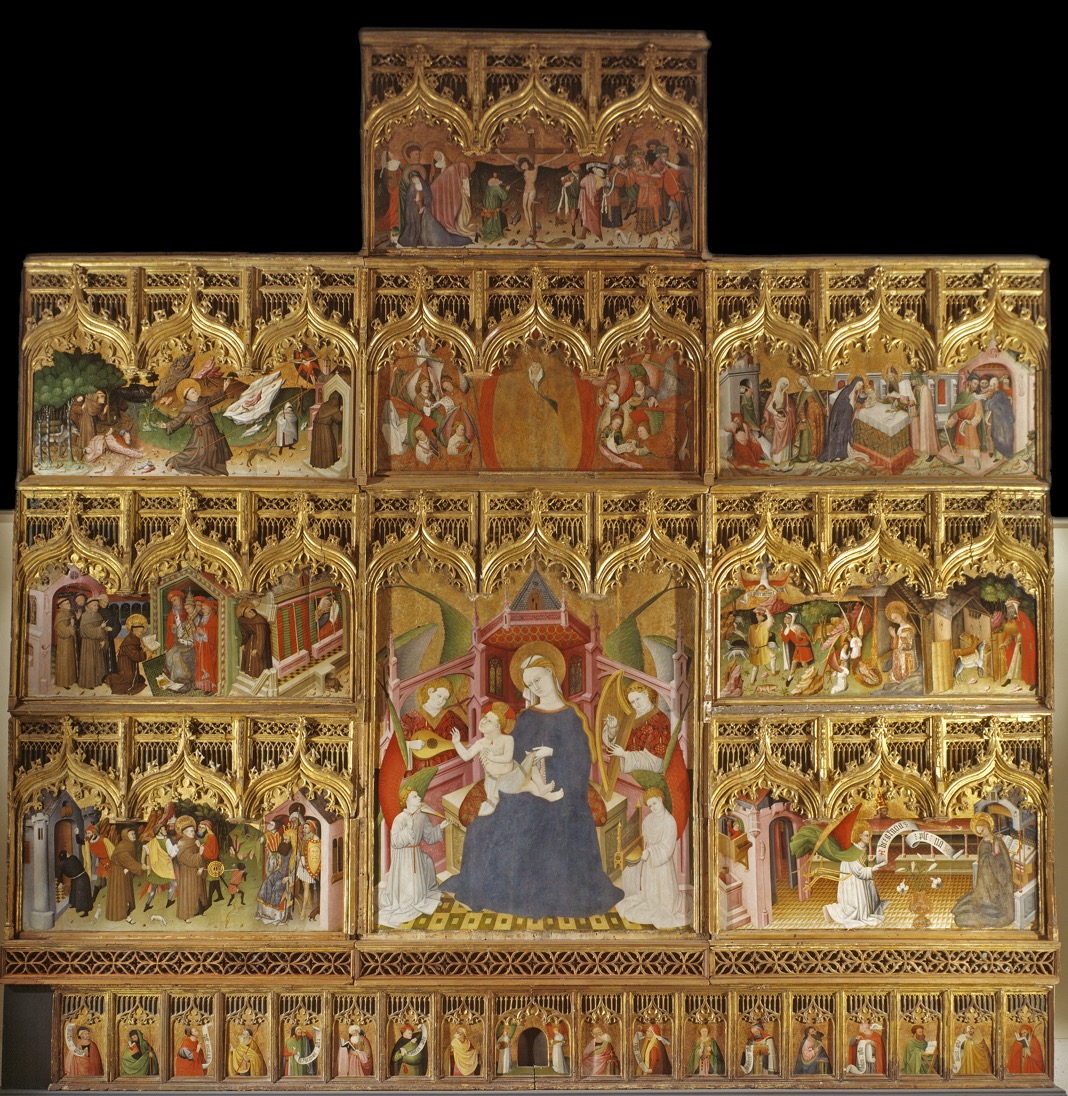
This altarpiece is also known as the Retable de la Virgen y de San Francisco (Life of the Virgin and Saint Francis) and was originally in a chapel of the Esteva de las Delicias near La Bañeza (near León). Esteva can mean “bed”, so this chapel might be called the Bed of Delights, and it is said to have been the chapel of a farm (granja).
The altarpiece is in three parts (9 panels), to the left is the life of San Francisco and the other two part treat the life of Christ and the Virgin, with the Virgin and Child as the centre-piece (surrounded by angels). Along the base (banco) are alternately 17 different apostles and prophets some bearing phylacteries (speech scrolls) with their names.
The painter, Nicolás Francés, was originally from Burgundy, but he spend a large part of his life in León (from 1434 to his death) and is considered to be a Spanish painter and miniaturist. He was first known for his work with stained glass in the cathedral. Francés is considered to be a representative of the International Gothic style, and it is known that he carved, designed for stained glass, and painted miniatures, altars, and murals. Experts have also suggested that his attention to detail are typical of an Italo-Flemish approach. International Gothic is a kind of fusion of Gothic with painting styles emerging from northern Italy in the 14th C and 15th C. What you expect to see is a certain dignified elegance, richly decorated colouring, elongated figures and flowing lines. Perspective is better understood, and there is a true attempt to set the figures within a specific context. So a mix of Gothic icon painting with rich Sienese colours, and a naturalism style that emerged in Italy and France. Nicolás Francés is one of three Castile painters that best captured this style, the other two being Dello Delli and his brother Nicolás Florentino. The mention of a Flemish influence is there to highlight the painters sense of realism and depth. On this altarpiece Francés also mixed the pigment with oil. The pigment dries slowly, leaving more time for the artist to add detail. Mixing painting techniques allowed Francés also to suggest transparency in textiles, and even show wrinkles on faces. An additional sense of volume is given by a good use of perspective, and the way the floor tiles provide depth.
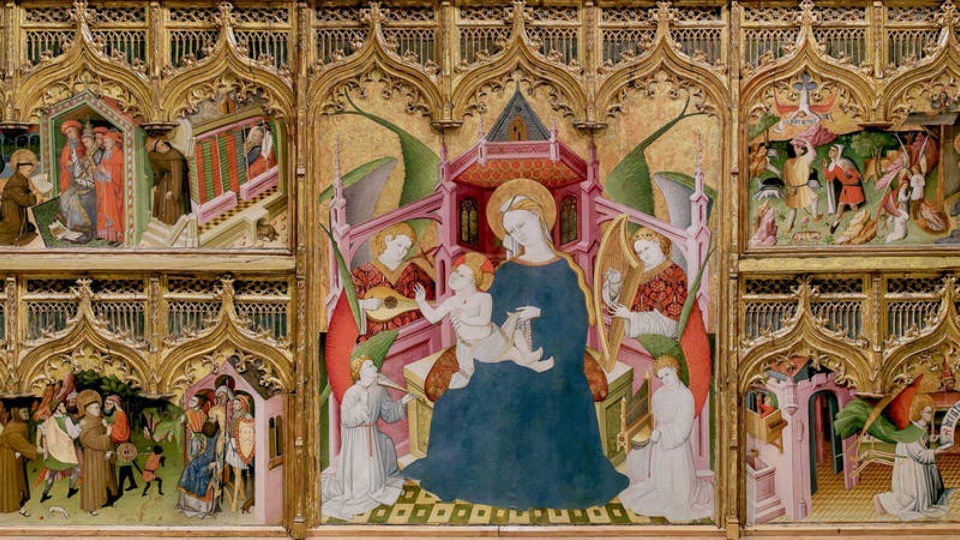
Above we have the centre-piece of the Virgin with Child, sitting on a Gothic throne. The Christ child carries a coral, which in medieval times was an amulet against the evil eye, indicating the superstitious character of the artist and the permissiveness of the Leonese clergy on this subject. Below we have in detail two of the panels.
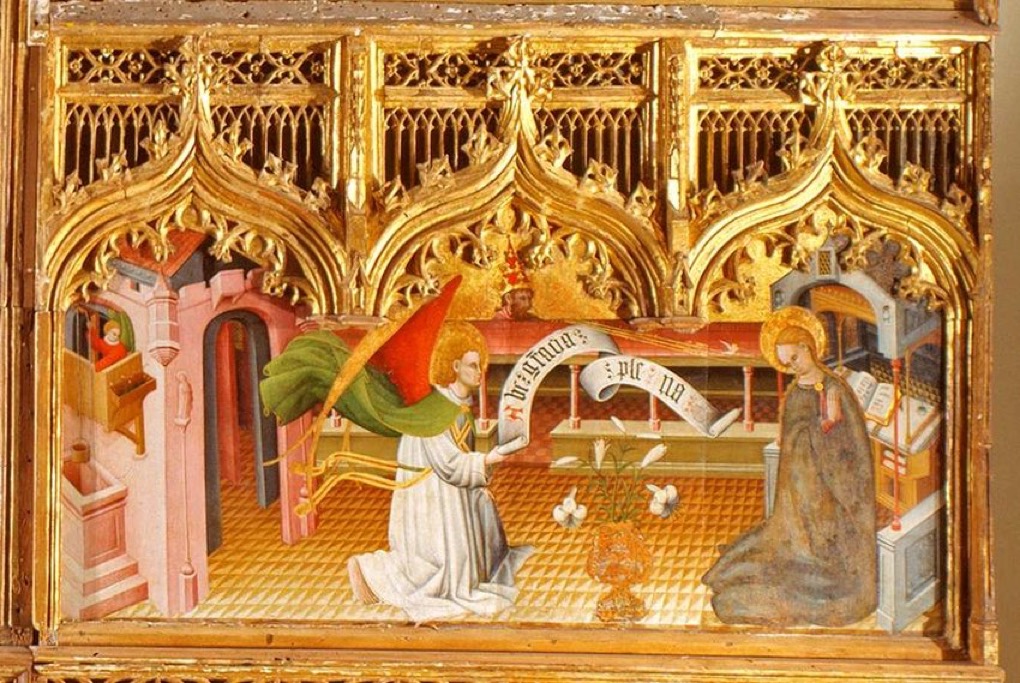

The artist stayed in León and developed much of his works in the area, so there are many documented references to his work and the relationship he had with his most important client, the cathedral. When he was first identified in the 19th C he became known as the artist of the 'high-handed brush'. It appears that he turned his hand to many things in the cathedral, stained glass we have mentioned, but he also painted weapons, and cleaned and gilded the cathedral organ. It was only later that experts started to tie together the various works in the cathedral to the same artist, and then to link the style to region of Dijon in France. Only then did they starting putting two-and-two together concerning both the extent of his work and the quality of execution, and only then they were able to associate it all with the Frenchman Nicolás Francés. Even at this time the Retable was not identified as his work. Later still they found a choir book with Christmas scenes in the hand of the painter. They were then able to attribute the stained glass work to the same artist. And finally working-back, the altar, stained glass, and church murals, as well as a painting were all attributed to Nicolás Francés.
We must remember that this altarpiece was created when there was an increased devotion to the saints. Clearly the Virgin occupied the central panel, with the Assumption above and topped with the Calvary. The right-hand panel is also dedicated to the Virgin and Child, but the left-hand panel is dedicated to San Francisco de Asís. In fact the rise of the Franciscan order made the iconography of the founder one of the richest and most prolific in the late Middle Ages. We see in the above panel San Francisco during his trip to Egypt in order to convert the Sultan of Babylon to Christianity. The exoticism of the presentation was much appreciated, and became a key component in the aesthetics of International Gothic. The painting does pamper to stereotypes of the time, with the fanciful headdress and sumptuous garments. But it remains a worthy altarpiece to close our visit to Museo del Prado.
___________________